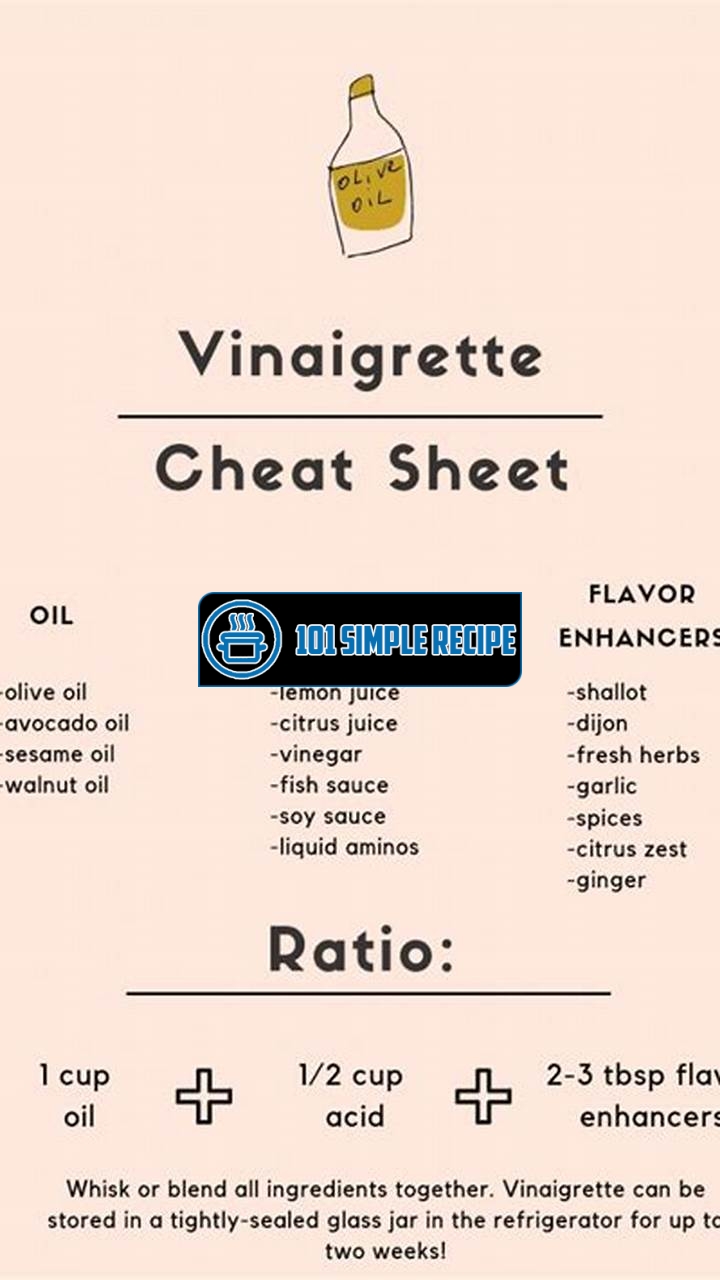Are you tired of bland salads and lackluster dressings? Look no further, because today you will learn how to master the art of making the perfect vinaigrette. Whether you are a seasoned home cook or just starting your culinary journey, this essential skill will elevate your salads, vegetables, and even sandwiches to new heights of flavor. In this article, we will guide you through the step-by-step process of creating a mouthwatering vinaigrette that will leave your taste buds dancing with joy. So let’s dive in and unlock the secrets of this versatile and delicious dressing.

Understanding the Vinaigrette Ratio Recipe
When it comes to elevating your salad dressing game, mastering the art of making the perfect vinaigrette is essential. One way to achieve this is by understanding and utilizing the vinaigrette ratio recipe. This recipe provides a precise balance between oil and acid that creates a harmonious blend of flavors in your dressing.
The Basics of Vinaigrette
Vinaigrette is a classic salad dressing made by combining oil and acid, such as vinegar or citrus juice. It serves as the foundation for countless dressing variations and can be customized to suit individual taste preferences. The vinaigrette ratio recipe acts as a guide to help you achieve the ideal balance of ingredients.
When preparing vinaigrette, it’s crucial to choose high-quality ingredients as they greatly impact the final result. Opt for extra virgin olive oil for its rich, fruity flavor, and select a vinegar that complements the other flavors in your dish. Common options include balsamic vinegar, red wine vinegar, and apple cider vinegar.
The vinaigrette ratio recipe typically consists of three parts oil to one part acid. However, this is not a strict rule and can be adjusted based on personal preference. Some may prefer a more acidic dressing, while others may enjoy a milder flavor. Experimentation is encouraged to find the perfect balance for your palate.
The Role of Oil in Vinaigrette
Oil plays a crucial role in vinaigrette by providing a smooth, creamy texture and carrying the flavors of other ingredients. Extra virgin olive oil is a popular choice due to its robust flavor and health benefits. It adds richness and depth to the dressing, enhancing the overall taste of your salad.
In addition to taste, oil also helps coat and protect the salad ingredients, allowing the dressing to adhere to the greens. This ensures each bite is evenly coated and bursting with flavor. When selecting oil for your vinaigrette, aim for a balanced and well-rounded flavor that complements the other components.
The Role of Acid in Vinaigrette
Acid acts as a counterpart to the oil, providing a tangy and bright flavor to the vinaigrette. Vinegar and citrus juices are commonly used acids in salad dressings. They add a refreshing zing that balances the richness of the oil and enhances the overall taste of the salad.
When choosing the acid for your vinaigrette, consider the flavors you want to highlight. Balsamic vinegar adds a sweet and robust element, while red wine vinegar provides a more tangy and acidic profile. Citrus juices, such as lemon or lime, offer a fresh and vibrant taste. Mixing different acids can also create unique flavor combinations.
In conclusion, understanding the vinaigrette ratio recipe is key to creating a perfect dressing that elevates your salads to new heights. By experimenting with oil and acid proportions, you can customize the flavor to suit your palate. Remember to choose high-quality ingredients for the best results, and enjoy the endless possibilities of vinaigrette variations.
Choosing the Right Ingredients
When it comes to creating the perfect vinaigrette, choosing the right ingredients is key. From oils to acids to herbs and spices, each component plays a crucial role in achieving the desired flavor and texture. In this section, we will explore the key components of a delicious vinaigrette and provide you with tips on how to select the best ingredients for your dressing.
Exploring Different Oils
The type of oil you use in your vinaigrette greatly impacts its taste and consistency. There are a variety of oils to choose from, each offering a unique flavor profile.
- Olive oil: Olive oil is a classic choice for vinaigrettes. It adds a rich, fruity, and slightly peppery taste to your dressing. Extra virgin olive oil, with its intense flavor, is perfect for bold and robust salads.
- Canola oil: Canola oil is a neutral-tasting and light oil that allows other flavors to shine. It is a great option if you want the flavors of your other ingredients to be more pronounced.
- Avocado oil: Avocado oil has a buttery and slightly nutty taste. It adds a creamy texture to your vinaigrette and pairs well with fresh greens and citrus-based dressings.
- Sesame oil: Sesame oil has a distinct nutty and toasty flavor. It is commonly used in Asian-inspired vinaigrettes and adds a delightful depth of flavor.
When selecting an oil for your vinaigrette, consider the overall flavor profile you want to achieve. Experiment with different oils to find the perfect balance for your taste buds.
Exploring Different Acids
Acids are the balancing agents in vinaigrettes, providing a tangy and bright flavor. There are various types of acids you can use in your dressing.
- Balsamic vinegar: Balsamic vinegar is a popular choice for vinaigrettes due to its sweet and syrupy texture. It pairs well with fruit-based dressings and adds a touch of complexity.
- Red wine vinegar: Red wine vinegar offers a mild and slightly fruity flavor. It works well with a variety of salad ingredients and adds a subtle tanginess.
- Apple cider vinegar: Apple cider vinegar has a slightly fruity and acidic taste. It adds a refreshing tang to your vinaigrette and complements salads with apples or pears.
- Lemon juice: Freshly squeezed lemon juice adds a bright and zesty flavor to your dressing. It pairs well with seafood salads and adds a burst of freshness.
When choosing an acid for your vinaigrette, consider the other components of your dressing and the taste you want to achieve. Combine different acids to create a unique and flavorful dressing.
Adding Flavor with Herbs and Spices
Herbs and spices are the secret ingredients that take your vinaigrette to the next level. They add depth, complexity, and aromatic notes to your dressing.
- Garlic: A staple herb in vinaigrettes, garlic adds a savory and pungent flavor. Use minced garlic for a stronger taste or roasted garlic for a milder yet aromatic flavor.
- Basil: Basil brings a fresh and slightly sweet flavor to your vinaigrette. It pairs particularly well with tomato-based salads or Mediterranean-inspired dressings.
- Dijon mustard: Dijon mustard adds a tangy and slightly spicy kick to your dressing. It helps emulsify the vinaigrette and gives it a smooth texture.
- Black pepper: Black pepper adds a mild heat and earthy flavor to your vinaigrette. It complements a variety of salad ingredients and elevates the overall taste.
Feel free to experiment with different herbs and spices to customize your vinaigrette based on your preferences. Don’t be afraid to mix and match to create a dressing that is truly your own.
Ranch oyster crackers recipe is a delicious snack that you can easily make at home. Serve them as an appetizer or enjoy them as a tasty snack.
Mastering the Vinaigrette Ratio
Are you tired of your vinaigrettes always turning out too tart or too oily? Mastering the vinaigrette ratio is the key to creating a perfectly balanced dressing every time. By learning the precise measurements and ratios, you can achieve a harmonious blend of acidity, sweetness, and richness that will elevate any salad or dish. In this article, we will delve into the art of creating the perfect vinaigrette and explore different ratios for unique specialty vinaigrettes.
The Classic Vinaigrette Ratio
The classic vinaigrette ratio is the foundation for countless dressing variations. It consists of three parts oil to one part acid. The oil provides a smooth and rich base, while the acid adds brightness and tanginess to enhance the flavors of your ingredients. Common oils used include olive oil, canola oil, and grape seed oil, while acid options range from red wine vinegar and balsamic vinegar to lemon juice and apple cider vinegar. To add a touch of sweetness, a hint of honey or maple syrup can be incorporated.
Key Points:
- The classic vinaigrette ratio is 3 parts oil to 1 part acid.
- Popular oils include olive oil, canola oil, and grape seed oil.
- Acid options range from red wine vinegar and balsamic vinegar to lemon juice and apple cider vinegar.
- For a touch of sweetness, add a hint of honey or maple syrup.
Adjusting the Ratio to Your Taste
While the classic vinaigrette ratio is widely accepted, don’t be afraid to adjust it to suit your personal preferences. You can experiment by increasing or decreasing the amount of acid or oil to achieve the desired flavor profile. If you prefer a more acidic dressing, increase the amount of vinegar or lemon juice. On the other hand, if you prefer a milder taste, add more oil to balance out the acidity. Remember to taste and adjust as you go until you find the perfect balance for your palate.
Key Points:
- Don’t hesitate to adjust the vinaigrette ratio to suit your taste.
- Increase the amount of acid for a tangier dressing.
- Add more oil for a milder, smoother flavor.
- Remember to taste and tweak until you achieve the desired balance.
Exploring Unique Ratios for Specialty Vinaigrettes
Now let’s dive into the exciting world of specialty vinaigrettes. Different ratios can create unique flavor profiles that complement specific ingredients or cuisines. For example, a 2:1 ratio of oil to acid works well for citrus-based dressings, where the acidity of the citrus juice adds a refreshing burst to your salads. A 1:1 ratio, on the other hand, is ideal for creamy vinaigrettes that call for ingredients such as mayo or yogurt. By experimenting with various ratios, you can elevate your vinaigrettes to new heights and explore a world of exciting flavors.
Key Points:
- Specialty vinaigrettes can have unique ratios to complement specific ingredients or cuisines.
- A 2:1 ratio of oil to acid works well for citrus-based dressings.
- A 1:1 ratio is ideal for creamy vinaigrettes.
- Experiment with different ratios to discover new and exciting flavors.
Remember, mastering the vinaigrette ratio is an art that comes with practice. Start with the classic ratio, understand your taste preferences, and then explore unique ratios to create specialty vinaigrettes. With these skills in your culinary toolbox, you’ll be able to whip up the perfect vinaigrette for any salad or dish, ensuring a delightful burst of flavor with every bite.
Enhancing Your Vinaigrette
Take your vinaigrette to new heights by incorporating additional ingredients and flavors. Adding unique twists to your vinaigrette can transform a simple salad dressing into a culinary masterpiece. Get ready to impress your taste buds with these creative ideas!
Sweet and Savory Variations
Experimenting with sweet and savory flavors is a fantastic way to elevate your vinaigrette. The combination of contrasting tastes adds depth and complexity to your dressing.
Honey and Dijon Mustard: Add a touch of sweetness by incorporating honey into your vinaigrette. Combine it with tangy Dijon mustard for a balanced and flavorful dressing that pairs well with salads containing fruits, nuts, and cheese.
Fruit Infusion: Infuse your vinaigrette with the natural sweetness of fruits like strawberries or raspberries. Simply puree the fruit and mix it into your dressing for a burst of fruity goodness. It’s a perfect accompaniment to salads featuring greens, goat cheese, and candied nuts.
Creamy Blue Cheese: For a rich and indulgent vinaigrette, add crumbled blue cheese. Its creamy and tangy flavor adds depth to your dressing, making it a great choice for hearty salads with grilled chicken, bacon, and avocado.
Experimenting with Different Vinegars
Vinegar is a key component of vinaigrette, and experimenting with different types of vinegar can dramatically alter the flavor profile of your dressing. Each variety brings a unique taste and acidity level to the table.
Apple Cider Vinegar: This fruity and slightly sweet vinegar pairs well with autumn-inspired salads, roasted vegetables, and dishes that contain apples or pears.
Balsamic Vinegar: Known for its intense flavor and dark color, balsamic vinegar adds a sweet and tangy note to your vinaigrette. It is often used in Mediterranean-style salads, Caprese salads, and dishes with grilled vegetables.
Champagne Vinegar: With its light and delicate taste, champagne vinegar is perfect for dressing light salads or seafood dishes. It adds a subtle tang without overpowering the other flavors.
Exploring Signature Vinaigrette Recipes
Many chefs and culinary experts have their own signature vinaigrette recipes that have been passed down through generations. Exploring these tried-and-true recipes can provide inspiration and help you develop your own unique vinaigrette blends.
Note: While it’s great to experiment and add your own personal touch, it’s important to respect the integrity of these signature recipes and give credit where it’s due.
Classic French Vinaigrette: This timeless recipe features a blend of Dijon mustard, red wine vinegar, garlic, and extra virgin olive oil. It’s a versatile dressing that complements a wide range of salads.
Citrus Vinaigrette: Made with fresh citrus juice (such as lemon or orange), white wine vinegar, and a hint of honey, this vibrant dressing adds a refreshing zest to any salad.
Raspberry Vinaigrette: Perfect for summer salads, this sweet and tangy dressing combines fresh raspberries, red wine vinegar, honey, and olive oil for a burst of fruity flavor.
By enhancing your vinaigrette with additional ingredients, exploring various vinegars, and delving into signature recipes, you’ll master the art of making the perfect vinaigrette. Get creative, experiment, and enjoy the journey of creating exquisite dressings that will elevate your salads to new heights!
Vinaigrette ratio recipe is the perfect way to make your own homemade salad dressing. Customize the flavors and ingredients to suit your taste preferences.
Tips for Dressing Your Salad
When it comes to making the perfect vinaigrette for your salad, there are a few key tips and techniques that can help you achieve the best results. By following these expert suggestions, you can ensure that your salad is properly dressed with the vinaigrette, resulting in even distribution of flavors and a delightful dining experience.
The Tossing Technique
One of the crucial steps in dressing your salad is mastering the tossing technique. To evenly coat the salad greens, place them in a large bowl and pour the vinaigrette over the top. Use two large forks to gently toss the salad, ensuring that every leaf gets a fair amount of dressing. This method allows the vinaigrette to cling to the greens, enhancing both the taste and appearance of the salad.
Expert Tip: For a more uniform distribution of the vinaigrette, consider using your hands to gently massage the dressing into the salad greens. This technique ensures that each leaf is thoroughly coated.
Layering the Dressing
Layering the dressing is another technique that can elevate the flavor and presentation of your salad. Instead of simply pouring the vinaigrette over the greens, try dressing the individual salad components separately. Begin by coating the base of the salad bowl with a small amount of vinaigrette, then add the salad greens on top. Drizzle another layer of dressing over the greens and continue layering with additional salad ingredients. This method guarantees that each element of the salad is infused with the flavors of the vinaigrette, providing a harmonious blend of tastes in every bite.
Expert Tip: When layering the dressing, start with the ingredients that will benefit the most from direct contact with the vinaigrette, such as grains, pasta, or root vegetables.
Dressing for Different Salad Types
Not all salads are created equal, which means that the dressing should be tailored to complement the specific ingredients and flavors in each dish. Here are a few guidelines to keep in mind when dressing different types of salads:
- For leafy green salads: Opt for a vinaigrette with a lighter consistency to avoid overpowering the delicate flavors of the greens. A simple mixture of olive oil, vinegar, and Dijon mustard works wonders.
- For grain or pasta salads: Consider using a bolder vinaigrette with robust flavors to stand up to the heartier ingredients. Experiment with ingredients like balsamic vinegar, garlic, and herbs to create a more complex taste profile.
- For fruit salads: Choose a vinaigrette that complements the sweetness of the fruits. Citrus-based dressings, such as lemon or orange vinaigrette, can add a refreshing twist to your fruity creations.
Expert Tip: Don’t be afraid to get creative with the vinaigrette ingredients. Adding a touch of honey, maple syrup, or even a hint of spice can take your dressing to the next level.
In conclusion, mastering the art of making the perfect vinaigrette is all about understanding the techniques for dressing your salad. The tossing technique ensures even distribution, while layering the dressing enhances the flavors. Lastly, matching the dressing to the salad type creates a harmonious balance. By following these expert tips, you’ll be well on your way to creating delicious and well-dressed salads that will impress your family and friends. Happy salad making!
Peanut butter cup recipe is a sweet and satisfying dessert that you can make in no time. Indulge in the rich and creamy combination of peanut butter and chocolate.
Thank you for taking the time to read our article on the vinaigrette ratio recipe. We hope that you found it informative and helpful for your future salad dressing endeavors. Don’t hesitate to bookmark this page and visit us again later for more delicious recipes and cooking tips. Your support and readership mean the world to us!
Frequently Asked Questions
Here are some frequently asked questions about the vinaigrette ratio recipe:
| No. | Questions | Answers |
|---|---|---|
| 1. | What is the vinaigrette ratio recipe? | The vinaigrette ratio recipe is a simple formula for making homemade vinaigrette dressing. It typically involves combining oil, vinegar, and other flavorings in a specific proportion to create a balanced dressing for salads and other dishes. |
| 2. | What are the common ingredients used in vinaigrette? | Common ingredients used in vinaigrette include olive oil, vinegar (such as balsamic, red wine, or apple cider vinegar), Dijon mustard, garlic, herbs, and salt and pepper. These ingredients can be adjusted to suit individual preferences and the desired flavor profile. |
| 3. | Can I substitute ingredients in the vinaigrette ratio recipe? | Absolutely! The beauty of the vinaigrette ratio recipe is its versatility. Feel free to experiment with different types of oils, vinegars, and flavorings to create your own unique vinaigrette variations. |
| 4. | How long does vinaigrette dressing last? | Vinaigrette dressing can generally be stored in an airtight container in the refrigerator for up to one week. However, it’s important to give it a good shake before using it, as the oil and vinegar may separate over time. |
| 5. | Can I make a large batch of vinaigrette in advance? | Yes, you can make a larger batch of vinaigrette ahead of time and store it in the refrigerator. Just be sure to whisk or shake it well before using, as the ingredients may settle or separate during storage. |
| 6. | What are some creative ways to use vinaigrette dressing? | Vinaigrette dressing can be used for more than just salads! Try using it as a marinade for grilled vegetables or meats, drizzling it over roasted vegetables, or even as a dip for bread. |
Come Back for More Delicious Recipes!
We hope you enjoyed learning about the vinaigrette ratio recipe and are inspired to try it out in your own kitchen. Remember to come back to our website regularly for more mouthwatering recipes, cooking tips, and culinary adventures. Happy cooking!
Jump to Recipe
The Vinaigrette Ratio Recipe

Learn the vinaigrette ratio recipe to create delicious homemade dressings for your salads and dishes. It’s a simple formula that allows you to customize the flavor and proportions to suit your taste.
- 1/4 cup olive oil
- 2 tablespoons vinegar (such as balsamic or red wine vinegar)
- 1 teaspoon Dijon mustard
- 1 clove garlic (minced)
- 1/2 teaspoon dried herbs (such as basil or oregano)
- Salt and pepper to taste
- In a small bowl, whisk together the olive oil, vinegar, Dijon mustard, minced garlic, dried herbs, salt, and pepper.
- Taste and adjust the seasoning if needed. If you prefer a sweeter dressing, you can add a touch of honey or maple syrup.
- Use immediately or store in an airtight container in the refrigerator for up to one week. Shake well before using.






